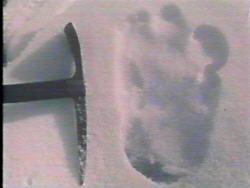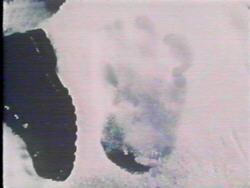
Eric Shipton cast, photographed and sketched this type specimen single track of an alleged yeti, which measured 13 inches toe to heel. The footprint was found in 1951 on Menlung Glacier.
Additional yeti tracks similar in shape to Shipton's came along about the same time: Lord John Hunt, Sir Edmund Hillary, Frank Smythe, H.W. Tilman, and Peter Byrne who found a string of tracks in 1948 on one of his first expeditions near the area of the Zemu Glacier at an altitude of 15,000 feet.
 None of these tracks resembled the imprint in snow of the local brown bears - bear tracks show claws and the yeti does not. Shipton's photograph show no claws.
None of these tracks resembled the imprint in snow of the local brown bears - bear tracks show claws and the yeti does not. Shipton's photograph show no claws.I have handled the Shipton Yeti footprint casts, in both positive and negative versions. There are 'reproductions' in circulation, which are mock-ups meant to represent the track. They do not represent the imprint faithfully in detail. The main thing about such reproductions is that they depict a relatively flat bottom with a smooth sole to the foot. The footprint is not all of one depth overall, it is much deeper off to the outside edge (darker in all the photographs of the footprint), which in the cast forms almost a ledge more than an inch deeper. The middle of the sole is shallower but has deep longitudinal wrinkles running through it, and the texture is not smooth but irregular. The toes are deeper again and as might be expected, the bigger toes are deeply imprinted while the smaller ones on the outside edge are barely printed at all.
The main concern I had was to see if the irregularities at the centre of the sole of the foot might be blurred claw marks. After I inspected both the negative and the positives of the track (the mold and the cast) it seems to me that they were not claw marks. At the SITU headquarters in the mid-1970s and shortly after Sanderson's death, Steve Mayn, Marty Wolf and I discussed the irregularities in Sanderson's copy of the footprint-in-the-box and we decided it was most likely scar tissue left because the foot had been injured going over irregularities such as sharp stones.
Which is why you can't go by the two greater toes the track shows. In my opinion the foot has been broken and the second toe healed improperly, and in part I have that opinion because it seems the sole of the foot shows other evidence of injury.
The footprint had been somewhat melted before preservation, though, and that seems to have been partly the reason why the outside of the heel was so much deeper than the rest of the track.


















1 comment:
I very clearly see an overlay of 2 footprints (or of 1 footprint over a "print" from something else) in this photograph.
Ignore the rightmost "big toe" and the irregular part at the bottom left. If you take the "second" toe as actually being the big toe, you will very clearly see a large-but-easily-within-normal-range male human footprint, pointing slightly (maybe 10 degrees) to the left of "vertical".
The foot that made this print looks like it would approximately fit the empty boot laid to the left of the print. It looks like the print was made on top of either a more "blurred" print from the same foot or some other natural depression in the snow.
Once i had seen that human foot the first time, i can't "unsee" it...
Post a Comment